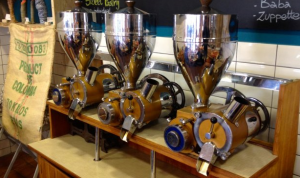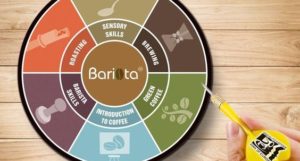Caffeine: How Much Does Roasting Affect it?
The most significant factors affecting caffeine levels in coffee:
1. Species
 One of the two principal factors affecting caffeine content is the species of coffee plant the beans come from.
One of the two principal factors affecting caffeine content is the species of coffee plant the beans come from.
There are many plants in the genus Coffea, but two species are grown commercially for coffee production, Coffea arabica and Coffea canephora (commonly known as robusta). They give us arabica and robusta coffee beans respectively.
Robusta contains about twice as much caffeine as arabica. This means that coffee brewed purely from robusta beans will have a higher caffeine content than arabica coffee.
Even within these two species, there is a small variation in the levels of caffeine present between different varietals (different “breeds” of the same species). There can even be differences in the amount of caffeine in the beans of two of the same plants growing side by side.
2. Preparation method
The other major factor affecting how much caffeine ends up in your cup is the preparation method. There is a multitude of different ways of turning roasted coffee beans into the rich and aromatic drink we know and love, and each method delivers varying amounts of caffeine.
Two of the most common ways of making coffee is “brewing” (which here is intended to include drip coffee, percolator and French press methods) and the espresso method.
Many people imagine that a shot of espresso contains more caffeine than coffee produced by brewing – but this depends on your definitions.
Espresso is often made with high-quality robusta beans and uses a very fine grind of coffee, resulting in a drink with a very high caffeine content. If you take a 1oz cup of espresso and a 1oz cup of brewed coffee, the espresso has far more caffeine.
However, since the size of a regular cup of brewed coffee is much larger than a 1oz espresso shot, in the end, if you drink brewed coffee, you are consuming more caffeine overall.
In other words, the espresso has more caffeine by volume, but brewed coffee has more caffeine per serving.
3. Brewing time
Longer brewing times allow more caffeine to be released. Therefore, brewing methods that require the water to be in contact with the coffee for longer, generally (but not always), tend to produce beverages with a higher caffeine content.
All other things being equal, the longer you brew the coffee, the higher the caffeine content of the resulting drink. However, it is thought that 90% of caffeine extraction occurs in the first minute of brewing. So, leaving it longer will only release limited amounts of extra caffeine, while potentially spoiling the flavor of the beverage.
4. Grind
The finer the grind, the larger the surface area of the coffee, allowing more caffeine to be released into the drink. This means that if two coffees are brewed from the same beans and under the exact same conditions, but one uses a finer grind, the latter will have more caffeine.
It is important to remember that grind size is one of the most important ways in which we control the flavor of coffee during the brewing process. Using a finer grind in an attempt to increase caffeine levels may result in an inferior drink.
5. Temperature
The temperature at which coffee is brewed has some effect on the amount of caffeine released, with higher temperatures delivering larger doses of caffeine.
The problem with higher temperatures is that other bitter compounds are also released, spoiling the flavor.
Cold-brewed coffee has a lower caffeine content than coffee brewed using hot-brewing techniques.
6. Amount of coffee used
Using a larger quantity of coffee will result in a beverage with a higher caffeine content, but the resulting flavor may be too strong.
7. Roast
Many people believe that coffee roast has a significant effect on caffeine content. Some claim that dark roast beans contain higher caffeine levels; others assert that dark roasting destroys the caffeine and that lighter roasts contain much more caffeine.
The truth, however, is that the roast of the coffee has little or no effect on the caffeine content since the compound remains very stable at the temperatures to which coffee beans are exposed during the roasting process.
Examples of caffeine levels in home-brewed coffee
As we have explained, there are so many variables affecting how much caffeine ends up in your cup of coffee. For this reason, it is impossible to give exact amounts per cup. The following is an approximate guide that can help estimate how much caffeine you are consuming.
Amounts stated are per 8oz serving.



